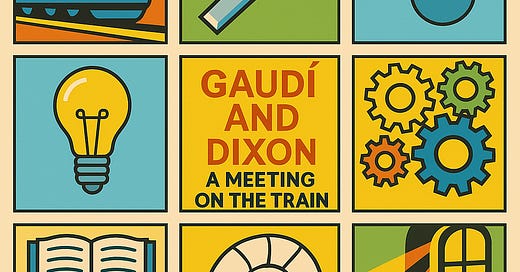Do you design instruction for deep, potentially difficult philosophical inquiry and critical struggle (Dixon-esque) or for creative refinement, structural support, and the illumination of possibilities (Gaudí-esque)? This fundamental decision is rooted in philosophy.

Listen to the podcast here!
The train rattled forward, the rhythmic clatter of wheels on tracks blending with the low murmur of passengers. Gaudí sat by the window, tracing the condensation on the glass with his finger, sketching invisible spirals and curves that only he could see. Beyond the glass, a vast countryside unfurled, its rolling hills softened by the golden haze of late afternoon.
Across from him, Dixon adjusted his coat and unfolded a newspaper, his spectacles perched precariously on his nose. The two men had exchanged polite nods when Dixon first took his seat, but now the silence between them felt heavier, charged with unspoken thoughts.
Dixon cleared his throat, folding his paper. “I suppose,” he began, his tone clipped and deliberate, “you’ve heard of this growing fascination with Artificial Intelligence in education. Machines teaching students to write. To think. It’s a troubling notion, wouldn’t you agree?”
Gaudí turned, his eyes curious, a faint smile playing on his lips. “Troubling? No, not at all. Writing is like architecture, no? Structured creation. AI is simply a tool, much like a compass or a chisel. It aids in shaping ideas, refining form, just as I’ve used geometry to shape stone.”
Dixon frowned, his brow furrowing as he leaned back against the seat. “A compass, you say? Geometry? Tools, perhaps, can shape structure. But can they teach wisdom? Can they guide a student to grapple with the eternal truths? Justice. Beauty. Truth. These machines mimic understanding, but they do not understand. How can they teach what they cannot grasp?”
The train jolted slightly, and Gaudí shifted in his seat, leaning forward. His voice was soft, thoughtful, as though he were speaking not only to Dixon but to the landscape rushing past the window. “And yet, is it not the structure that leads to understanding? A cathedral begins with scaffolding, a framework that allows the craftsman to climb higher, to shape the stones that will hold the heavens. AI provides that scaffolding for students. It clears the way for imagination to soar, for meaning to emerge.”
Dixon crossed his arms, his gaze fixed on the seatback in front of him. “But what of the journey? What of struggle? A student must wrestle with words, search for meaning, stumble and fall before they find the right phrase, the perfect thought. AI shortcuts that process. It hands over answers without effort. And without effort, there is no true understanding.”
Gaudí turned his gaze back to the window, his finger tracing a new pattern on the glass. “Have you ever watched a craftsman work, Mr. Dixon? A stonemason with a well-honed chisel? Would you deny him that tool, force him to carve with his hands alone? The tool does not diminish his labor. It refines it, allows him to focus on the artistry, on the vision.”
The train slowed as it approached a small station, the hiss of the brakes cutting through their conversation. Dixon sighed, his tone softening. “Perhaps. But who wields the tool matters. What meaning will the machine impart? Will it teach virtue? Will it inspire courage? Or will it simply churn out polished, hollow works, a reflection of its own emptiness?”
Gaudí smiled faintly, his eyes drifting toward the platform as the train came to a halt. “The tool itself does not decide its purpose. A hammer can build a cathedral or destroy it. The human mind remains the architect. If we guide AI with purpose, if we design it well, it can help us reveal the divine patterns in our writing, in our art, in our very thoughts.”
Dixon opened his mouth as if to respond, but the train lurched forward again, its momentum carrying them further into the fading light. He adjusted his spectacles, gazing out at the countryside, the silence between them now layered with thought.
For a moment, the only sound was the steady rhythm of the train, carrying them both toward a destination neither could quite see.


